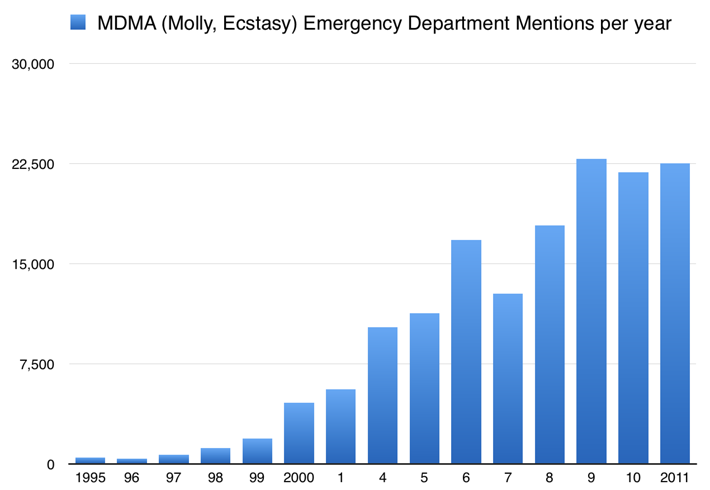History of Ecstasy (MDMA)
Early ecstasy

MDMA was patented in 1913 (patent #274.350) by the German chemical company Merck supposedly to be sold as a diet pill (the patent does not mention any intended use), the company decided against marketing the drug and had nothing more to do with it.
An urban legend has the US army testing MDMA in 1953 as a possible truth serum, but there is no real evidence supporting this.
The man responsible for the modern research of MDMA is Alexander Shulgin, who after graduating from the University of California at Berkeley with a Ph.D. in Biochemistry landed a job as a research chemist with Dow Chemicals. Among his many achievements for Dow Chemicals were one profitable insecticide and several controversial patents for what were to become popular street drugs. Dow was happy with the insecticide but Shulgin’s other projects created a parting of the way between the biochemist and the chemical company. Alexander Shulgin is also the first reported human to use MDMA.
Shulgin continued his legal research of new compounds after leaving Dow, specializing in the phenethylamines family of drugs. MDMA is but one of 179 psychoactive drugs which he described in detail, but it is the one which he felt came closest to fulfilling his ambition of finding the perfect therapeutic drug.
Since MDMA had already been patented in 1913, it held no profit potential for a drug company, as a drug cannot be patented twice and before marketing a new drug, a company has to show that the potential side effects are justified by the drug’s benefits as a medicine, and this involves long and expensive trials. The only way of recouping that expense is by obtaining exclusive rights to sell the drug through holding its patent. Only a few experimental therapists researched and tested the drug (between 1977 to 1985) for use during psychotherapy sessions.
DEA Bans MDMA/Ecstasy
In 1985, MDMA/Ecstasy received massive media attention when a group of people sued the US Drug Enforcement Agency (DEA) to try to prevent them from outlawing the drug by placing it on Schedule 1. The US Congress had passed a new law allowing the DEA to put an emergency ban on any drug that it thought might be a danger to the public. On July 1st, 1985, this right was used for the first time to ban MDMA.
A hearing was held to decide what permanent measures should be taken against the drug. One side argued that MDMA caused brain damage in rats, the other side claimed this might not be true for humans and that there was proof of the beneficial use of MDMA as a drug treatment in psychotherapy. The presiding judge after weighing the evidence recommended that MDMA be placed on Schedule 3, which would have allowed it to be manufactured, used on prescription and subject to further research. But the DEA decided to place MDMA permanently on Schedule I.
Trial research into the effects of MDMA on human volunteers resumed in 1993 with the approval of the Food and Drug Administration (FDA), the first psychoactive drug approved for human testing by the FDA.
Trends in Ecstasy / MDMA use
The synthetic drug “ecstasy,” which has been used increasingly among college students and young adults in recent years, also is being used at relatively high levels by America’s 8th, 10th, and 12th graders, according to NIDA’s 1996 Monitoring the Future study. Nearly 5 percent of 10th and 12th graders and about 2 percent of 8th graders said they had used MDMA in the past year, the study reported.
Ecstasy, or MDMA (3,4-methylenedioxymethamphetamine), is structurally similar to methamphetamine and the hallucinogen mescaline. Previous Monitoring the Future studies asked 12th graders about the use of MDMA by their friends and about the drug’s availability. The 1996 study was the first to question 8th, 10th, and 12th graders about their own use of the drug. The new data on MDMA use among these students will provide baseline information that will be helpful in tracking trends in MDMA use from a younger age.
MDMA use rose sharply among college students and young adults during the 1990s, according to the yearly Monitoring the Future study. The 1995 study included follow-up data on drug use among a representative sample of college students and young adults who had previously taken part in the study when they were in high school. College students and young adults in this sample have been surveyed every two years since the Monitoring the Future study began in 1976. In recent years there has been a lot of media attention and concern regarding the dangers of Ecstasy use amongst young people, particularly those who attend raves and festivals where several fatalities have occurred related to its use. The DEA reported on emergency department mentions regarding MDMA with this graph that shows a steady increase since the year 2000.

Related Article: Ecstasy Today
See also Ecstasy Addiction | Ecstasy Timeline | Effects of Ecstasy
 ®
®